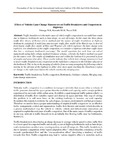Effects of Vehicles Lane-Change Manoeuvres on Traffic Breakdown and Congestion in Highways
Abstract
Traffic breakdown is the main cause of vehicle traffic congestion in our multi-lane roads
due to highway bottlenecks such as lane-drops, on and off-ramps. In this study the three phase
traffic flow theory of Kerner [1] is outlined and the nature of traffic breakdown at highway
bottlenecks explained. A multi-lane macroscopic traffic flow model of Aw-Rascle type is derived
from kinetic traffic flow model of Klar and Wegener [2], which expresses the lane change term
explicitly. For simulation of this traffic congestion, we consider a highway with three traffic lanes
that has a stationary bottleneck (on-ramp). The model equations for each lane are solved
numerically using finite volume method (Godunov scheme), whereby the Euler's method was used
for the source term. The results of simulation near and within the bottleneck is presented in form
of graphs and space-time plots. These results indicate that vehicle lane-change manoeuvres lead
to heavy traffic breakdown and congestion on the right lanes compared to the left lane adjacent to
the bottleneck. This is due to the merging of vehicles from on-ramp prompting the following vehicle
moving in the left lane of the highway to either slow down upon reaching the disturbance region
or change to the right lanes before the vehicle reaches the merging zone.
Keywords: Traffic breakdown, Traffic congestion, Bottlenecks, Godunov scheme, Merging zone,
Lane-change manoeuvre.

